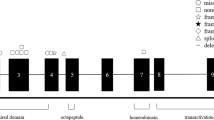Abstract
Autosomal recessive polycystic kidney disease (ARPKD) is one of the major hereditary nephropathies in children predominantly presenting in early childhood. The clinical picture is variable but there is a fatal outcome in many cases. We have performed linkage analysis in 16 ARPKD families and localized the ARPKD gene to chromosomal region 6p21–cen with no evidence for genetic heterogeneity among different clinical phenotypes. Linkage was confirmed using six adjacent microsatellite markers and the highest lod score of 7.42 was obtained with D6S272 at θ=0.00. Our findings should lead to more accurate forms of prenatal diagnosis than those currently available using ultrasound.
This is a preview of subscription content, access via your institution
Access options
Subscribe to this journal
Receive 12 print issues and online access
$209.00 per year
only $17.42 per issue
Buy this article
- Purchase on Springer Link
- Instant access to full article PDF
Prices may be subject to local taxes which are calculated during checkout
Similar content being viewed by others
References
Zerres, K., Rudnik-Schönebom, S. & Deget, F. Childhood onset autosomal dominant polycystic kidney disease in sibs: clinical picture and recurrence risk. J. med. Genet. 30, 583–588 (1993).
Cole, B.R. Autosomal recessive polycystic kidney disease. In The cystic kidney (eds K.D. Gardner & J. Bernstein) 326–350 (Kluwer Academic Publishers, Dordrecht, London, Boston, 1990).
Reeders, S.T. et al. A higly polymorphic DNA marker linked to adult polycystic kidney disease on chromosome 16. Nature 317, 543–544 (1985).
Romeo, G. et al. A second genetic locus for autosomal dominant polycystic kidney disease. Lancet 2, 8–10 (1988).
Kimberling, W.J. et al. Linkage heterogeneity of autosomal domlnant polycystlc kidney disease. New Engl. J. Med. 319, 913–917 (1988).
Pafrey, P.S. et al. The diagnosis and prognosis of autosomal dominant polycystic kidney disease. New Engl. J. Med. 323, 1085–1090 (1990).
Kimberling, W.J. et al. Autosomal dominant polycystic kidney disease: localization of the second gene to chromoosme 4q13–q23. Genomics 18, 467–472 (1993).
Peters, D.J.M. et al. Chromosome 4 localization of a second gene for autosomal dominant polycystic kidney disease. Nature Genet. 5, 359–362 (1993).
Zerres, K., Hansmann, M., Mallmann, R., Gembruch, U. Autosomal recessive polycystic kidney disease. Problems of prenatal diagnosis. Prenat. Diag. 8, 215–229 (1988).
Neumann, H.P.M. et al. Late manifestation of autosomal-recessive polycystic kidney disease in two sisters. Am. J. Nephrol. 8, 194–197 (1988).
Blyth, H. & Ockenden, B.G. Polycystic disease of kidneys and liver presenting in childhood. J. med. Genet. 8, 257–284 (1971).
Zerres, K. Autosomal recessive polycystic kidney disease. J. clin. Invest. 70, 794–801 (1992).
Kaplan, B.S., Fay, J., Shah, V., Dillon, M.J. & Barratt, T.M. Autosomal recessive polycystic kidney disease. Pediatr. Nephrol. 3, 43–49 (1989).
Zerres, K., Vöipel, M.C. & Weiß, H. Cystic kidneys. Genetics, pathologic anatomy, clinical picture and prenatal diagnosis. Hum. Genet. 68, 104–135 (1984).
Hildebrandt, F., Pohlmann, A. & Omran, H. Lodview: a computer program for the graphical evaluation of lod score results in exclusion mapping of human disease genes. Comp. Biomed. Res. 26, 592–599 (1993).
Matise, T.C., Perlin, M. & Chakravarti, A. Automated construction of genetic linkage maps using an expert system (MultiMap): a human genome linkage map. Nature Genet. 6, 384–390 (1994).
Wirth, B. et al. Autosomal recessive and dominant forms of polycystic kidney disease are not allelic. Hum. Genet. 77, 221–222 (1987).
Zerres, K., Mücher, G. & Rudnik-Schöneborn, S. Autosomal recessive polycystic kidney disease does not map to the second gene locus for autosomal dominant polycystic kidney disease on chromosome 4. Hum. Genet. (in the press).
Guay-Woodford, L.M., D'Eustachio, P., Mücher, G., Uhlhaas, S. & Zerres, K. Testing the hypothesis that murine congenital polycystic kidney disease (cpk) and human autosomal recessive polycystic kidney disease (ARPKD) affect homologous genes. J. Am. Soc. Nephrol. 1, 300A (1990).
Kwiatkowski, T.J., Beaudet, A.L., Trask, B.J. & Zoghbi, H.Y. Linkagemapping and fluorescence in situ hybridisation of TCTE1 on human chromosome 6p: Analysis of dlnucleotide polymorphisms on native gels. Genomics 10, 921–926 (1991).
Weissenbach, J. et al. A second-generation linkage map of the human genome. Nature 359, 794–801 (1992).
Brzustowicz, L.M. et al. Genetic mapping of chronic childhood-onset spinal atrophy to chromosome 5q11.2–13.3. Nature 344, 540–541 (1990).
Sambrook, J., Fritsch, E.F. & Maniatis, T. Molecular cloning: A laboratory manual 2nd edn (Cold Spring Harbor Laboratory, New York 1989).
Lathrop, G.M., Lalouel, J.M., Julier, C. & Ott, J. Multilocus linkage analysis in humans: Detection of linkage and estimation in humans: Detection of linkage and estimation of recombination. Am. J. hum. Genet. 37, 482–498 (1985).
Author information
Authors and Affiliations
Rights and permissions
About this article
Cite this article
Zerres, K., Mücher, G., Bachner, L. et al. Mapping of the gene for autosomal recessive polycystic kidney disease (ARPKD) to chromosome 6p21–cen. Nat Genet 7, 429–432 (1994). https://doi.org/10.1038/ng0794-429
Received:
Accepted:
Issue Date:
DOI: https://doi.org/10.1038/ng0794-429
This article is cited by
-
Histopathology and molecular pathology confirmed a diagnosis of atypical Caroli’s syndrome: a case report
Diagnostic Pathology (2024)
-
NEDD4-family E3 ligase dysfunction due to PKHD1/Pkhd1 defects suggests a mechanistic model for ARPKD pathobiology
Scientific Reports (2017)
-
Clinical and genetic characterization of a founder PKHD1 mutation in Afrikaners with ARPKD
Pediatric Nephrology (2015)



